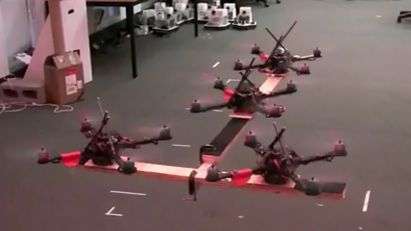July 16, 2010 report
GRASP lab demonstrates quadrotors (w/ Video)

(PhysOrg.com) -- Quadrotors, robotic vehicles resembling tiny helicopters, have been demonstrated by a group of scientists in the US. The quadrotors were shown carrying out impressive maneuvers and lifting payloads both singly and in groups working together.
A quadrotor (also called a quadrocopter) is a vehicle lifted and flown by means of four rotors. The quadrotor is maneuvered by adjusting the relative speed of each of the four rotors. Unlike standard helicopters, the blades on quadrotors are fixed pitch.
The unmanned autonomous vehicles (UAVs) were developed by computer science, mechanical engineering and electrical engineering students at the University of Pennsylvania’s General Robotics, Automation, Sensing and Perception (GRASP) laboratory. Each tiny vehicle has a claw-like grip it can use to pick up an object weighing around 0.5 kg, but the vehicles can work in groups to pick up heavier payloads.
The Quadrotors are highly maneuverable, and can flip multiple times and fly through windows or between other quadrotors, with only a few centimeters’ clearance on each side. When fitted with Velcro under the vehicle and on a surface, the quadrotors can perch on inclined, vertical or even inverted surfaces.
The GRASP laboratory is not the only group working on miniature UAVs for lifting payloads. As PhysOrg reported in June, a group in Switzerland has demonstrated a "distributed flight array" of robotic vehicles working together to lift objects. The Swiss group’s robotic vehicles work as a multiple vehicle flight platform and only fly erratically as single units, whereas the Pennsylvania group’s vehicles function well individually.
© 2010 PhysOrg.com



















